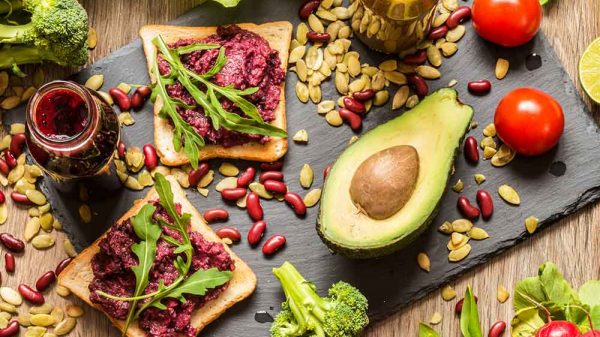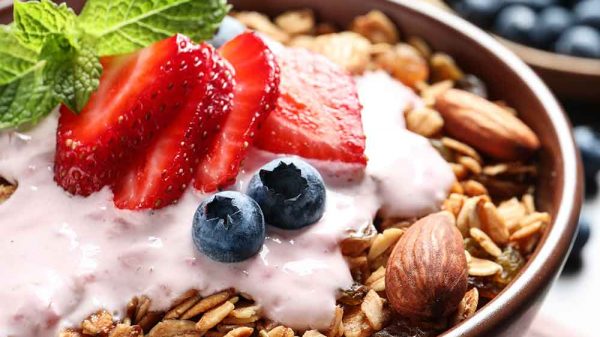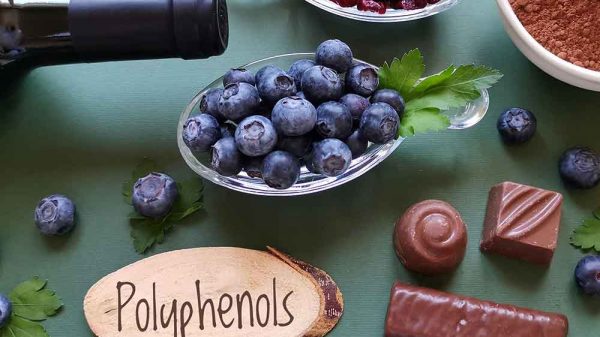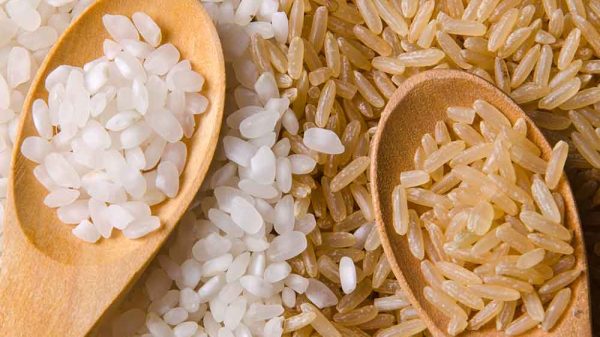Counting macros is a useful strategy, whether you are striving for weight loss or weight gain. Counting macros is also helpful when you are aiming to gain muscle mass. But can you also count macros if you are vegan? Here we go through everything you need to know about tracking vegan macros to achieve your health and fitness goals. Read on to learn more about counting macros on a plant-based diet, including meal ideas and other tips.
What Is a Macronutrient?
Before we go further, let’s first talk about what a macronutrient is. A macronutrient is a component of food that provides calories or energy. The three macronutrients in food are fats, proteins, and carbohydrates. A gram of either fat, protein, or carbohydrates has different energy densities and offers a different number of calories. A gram of fat provides 9 calories per gram, while protein and carbohydrates provide 4 calories per gram.
Macronutrients differ from micronutrients because they provide the energy that the body requires to carry out all biological functions. For example, fats serve as structural components of all cell membranes. Proteins make up muscle tissue, neurotransmitters, and enzymes. Carbohydrates are converted into glucose, which the mitochondria use to produce adenosine triphosphate (ATP) for energy.
Counting macros ensures that you’re getting an ideal number of carbohydrates, fats, and proteins for your needs.
How to Track Macros on a Vegan Diet
The biggest challenge when it comes to tracking macros on a vegan diet is knowing which foods count as which macros.
Vegan Carbohydrates
Carbohydrates on the vegan diet aren’t much different from those on an omnivorous diet. Because of the composition of animal products, most carbohydrate-rich foods are plant-based. Whole grains, fruits, and veggies are healthy sources of carbohydrates.
Added sugars are also carbohydrates. However, it’s a good idea to steer clear of added sugars like those found in soda, candy, and other packaged foods.
Vegan Fats
Vegan macros from fats come primarily from nuts, seeds, and vegetable oils. Plant-based fats mainly contain monounsaturated and polyunsaturated fats. These fats offer many more health benefits than the saturated fats found in foods like steak, bacon, pork, cheese, milk, and cream. Animal-based saturated fats contribute to heart disease and inflammation, while healthy plant-based fats help lower systemic inflammation.
Vegan Proteins
This is where a vegan diet will deviate significantly from an omnivorous diet. It’s important to pay special attention to protein intake on the vegan diet. While on an omnivorous diet, the primary protein sources are meat, dairy, and eggs, the primary protein sources on a vegan diet are nuts, seeds, beans, and whole grains. A common misconception is that vegan protein sources don’t offer enough protein. You can get more than enough grams of protein from plant-based protein. The amount of protein that you eat is important. However, when following a vegan diet, the catch is that you must ensure that you’re getting optimal ratios of essential amino acids.
Amino acids are the building blocks that make up protein. When we eat dietary protein, the body breaks down protein into individual amino acids, which are then shuttled throughout the body for use in various biological mechanisms. Essential amino acids are particularly important to get in your diet daily since the body is unable to synthesize essential amino acids internally.
While animal proteins offer ideal ratios of essential amino acids, vegetable proteins are missing at least one of the essential amino acids. As a result, it’s necessary to eat various vegetable protein sources throughout the day, to ensure that you’re not missing any amino acids. Good sources of plant proteins include foods like nut butters, walnuts, almonds, flaxseed, chia seeds, hummus, black beans, chickpeas, edamame, tofu, and tempeh.
Tips for Tracking Vegan Macros
Here are a few tips for tracking vegan macros to make the process as easy as possible.
1. Tailor Macros to Your Needs
Each macronutrient provides a proportion of your total caloric intake. For example, maybe 15% of your daily calories come from protein, 60% come from carbohydrates, and 25% come from fat. On a typical 2,000-calorie diet, this means that you would consume 75 grams of protein, 300 grams of carbs, and about 56 grams of fat to satisfy your daily macro requirements.
However, not everyone will require a 2,000 calorie diet with these exact macro ratios. If you count macros to burn fat and lose weight, you may need to eat fewer calories and low-carb meals to create a calorie deficit and encourage fat loss. Or, if you are very active and engage in regular cardiovascular exercise and strength training, you may need to increase your total calories and track macros for building muscle. As a result, you may need to tailor your macros to a high-protein, high-carb plan.
Consulting a nutritionist or dietitian is a good idea when devising your macro plan. A nutritionist will consider your physical activity level, health conditions, body composition goals, metabolism, and other factors that influence your nutrient intake.
2. Use a Macro Tracking App
Macros tracking apps and macro calculators are valuable resources when counting the macronutrient content of your diet. MyFitnessPal and IIFYM (If It Fits Your Macros) are two popular examples.
A macro tracking app can also help you determine the number of carbohydrates that are present in whole foods that don’t have food labels, such as sweet potatoes or bananas.
3. The Healthiest Macros Are Whole Foods
When aiming to follow a vegan diet and count macros, aim to eat primarily whole foods. Whole, unprocessed foods are highly nutritious and offer various micronutrients like vitamins, minerals, fiber, and antioxidants.
4. Don’t Deprive Yourself of the Occasional Treat
Counting macros- whether following a vegan diet or another diet – allows you to consume treats that still fit within your plan.
Though you should generally avoid eating junk foods, having an occasional treat is important. You should still enjoy eating out with friends, holidays, and other times when delicious but unhealthy food may be available. Counting macros allows for a less restrictive lifestyle that encourages a healthy relationship with food. For example, if you go out for coffee with a friend and get a donut, you can count the donut into your macros for the day.
5. Staying Flexible
Your lifestyle and needs may change with different life events and goals. Your macro and calorie intake may change over time. Tracking macros allows you to follow flexible dieting plans that can be tailored to fit your changing needs. Always make sure that your macros plan keeps up with what you need.
6. Don’t Worry About Portion Sizes
As long as the meals are fitting your macros, don’t worry about portion sizes. When following a plant-based diet, it’s normal to be eating larger volumes of food. This is because many plant foods like fruits and veggies have a low calorie density. As a result, your plate may look more full than it should be, even if the serving is offering ideal macro ratios.
7. Use Food Labels
The nutrition facts on food labels are indispensable resources when it comes to calculating macros. Food labels offer information regarding the number of grams of protein, carbohydrates, and fats.
In addition to calculating macros, food labels are also important for evaluating the nutritious benefit of a food product. Always check food labels to ensure there is little or no added sugar, saturated fat, and unhealthy preservatives.
Meal and Snack Ideas When Counting Vegan Macros
Balancing your macros during meals is a good idea, and it’s helpful to have a vegan meal plan that fits your macros. Your food choices when following a vegan diet can be both tasty and healthy! Here are a few ideas of vegan meals that you can incorporate into your vegan macros meal plan.
1. Veggie Stir-Fry with Rice
A stir-fry is one of the easiest ways to incorporate all macronutrients into one meal while also keeping your micronutrient intake high. To prepare a veggie stir-fry, first slice up a few vegetables of your choice. Onions, garlic, broccoli, carrot, fennel, snow peas, and cabbage are a few ideas. Saute in olive oil until tender and fragrant, and season with spices of your choice. Curry, coconut milk, lemongrass, and salt complement each other beautifully. For extra protein, add tofu and chickpeas. Serve over a bed of brown rice and enjoy.
2. Lentil Stew
Lentil stew is an easy nutritious way to get the healthy macronutrients and micronutrients that you need. To prepare your lentil stew, saute garlic, onions, carrots, and fennel in a pan with olive oil. Add chopped potatoes, lentils, and vegetable broth, and season with oregano, cumin, salt, pepper, red pepper flakes, and thyme. Simmer until the lentils and potatoes are tender. Top with a squeeze of lemon juice and serve over quinoa.
3. Spaghetti with Greens and White Beans
This Italian-inspired recipe idea also provides a balance of protein, carbs, and fat. To prepare your pasta topping, saute onions, garlic, roasted red peppers, and spinach in a pan. Make sure to use lots of spinach, because when cooked, spinach shrinks considerably. Add white beans or cannellini beans to the mixture. Season your dish with salt, pepper, oregano, and red pepper flakes for a spicy kick.
Pour your sauce onto whole-grain pasta of your choice and drizzle with olive oil and a squeeze of lemon juice. Missing the parmesan cheese? Add a sprinkle of nutritional yeast for a cheesy element. Alternatively, grocery stores sometimes offer a vegan parmesan alternative.
4. Protein Shakes
If your goal is to make vegan gains, then you’ll want to add protein shakes to your daily routine. Vegan protein shakes are an excellent way to amp up the protein and calorie content of your diet. To prepare a muscle-building shake, first add two frozen bananas to the blender along with 2 tablespoons of peanut butter.
Next, add frozen blueberries, ground flaxseed, soymilk, and your favorite vegan protein powder or essential amino acid supplement. Want to enhance the calorie content even more? Add in half an avocado and oats for a creamier, heartier shake. This shake is an excellent post-workout option and even works as a meal replacement.
5. Chopped Salad
Salads are popular vegan foods. However, salads don’t have to be boring! To prepare a vegan salad that offers a balance of macronutrients and micronutrients, start out by choosing your favorite greens and chopping them into bite-size pieces. Arugula, kale, and spinach are great options. Top with chopped tomatoes, red onions, and cucumbers.
For a crunchy element that offers both healthy fats and protein, sprinkle your salad with crushed walnuts or pumpkin seeds. For protein and fiber, mix in black beans and a serving of quinoa. Toss with a creamy avocado dressing and fresh herbs.
Counting Vegan Macros: Conclusion
Tracking macros helps you attain your health and fitness goals, whether you are trying to lose body fat, build muscle, or both. The bottom line is that counting vegan macros is not too much different from counting macros on an omnivorous diet. However, keep in mind that on a vegan diet, it’s important to eat a variety of plant-based protein and stick to whole foods. The vegan diet benefits health and fitness most when it is composed of primarily whole foods and fewer processed ingredients.
























